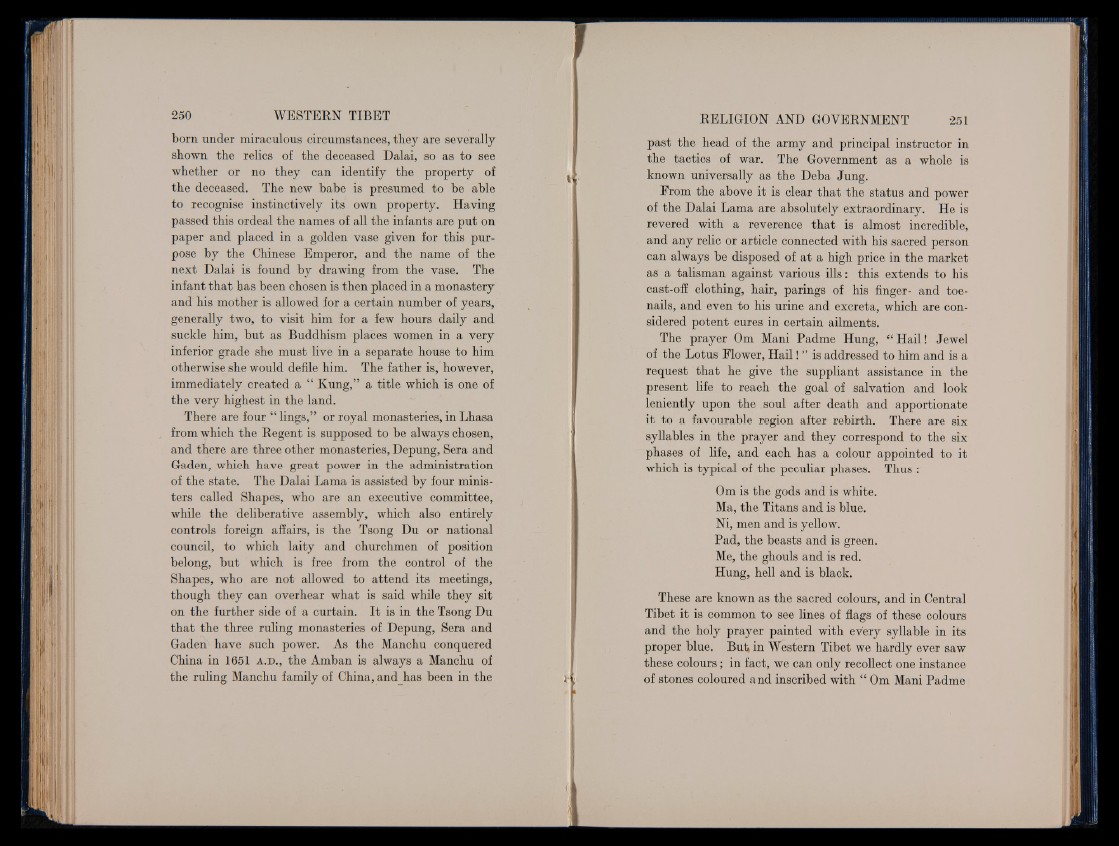
born under miraculous circumstances, they are severally
shown the relics of the deceased Dalai, so as to see
whether or no they can identify the property of
the deceased. The new babe is presumed to be able
to recognise instinctively its own property. Having
passed this ordeal the names of all the infants are put on
paper and placed in a golden vase given for this purpose
by the Chinese Emperor, and the name of the
next Dalai is found by drawing from the vase. The
infant that has been chosen is then placed in a monastery
and his mother is allowed for a certain number of years,
generally two, to visit him for a few hours daily and
suckle him, but as Buddhism places women in a very
inferior grade she must live in a separate house to him
otherwise she would defile him. The father is, however,
immediately created a “ Kung,” a title which is one of
the very highest in the land.
There are four “ lings,” or royal monasteries, in Lhasa
from which the Regent is supposed to be always chosen,
and there are three other monasteries, Depung, Sera and
Gaden, which have great power in the administration
of the state. The Dalai Lama is assisted by four ministers
called Shapes, who are an executive committee,
while the deliberative assembly, which also entirely
controls foreign affairs, is the Tsong Du or national
council, to which laity and churchmen of position
belong, but which is free from the control of the
Shapes, who are not allowed to attend its meetings,
though they can overhear what is said while they sit
on the further side of a curtain. It is in the Tsong Du
that the three ruling monasteries of Depung, Sera and
Gaden have such power. As the Manchu conquered
China in 1651 a.d ., the Amban is always a Manchu of
the ruling Manchu family of China, and has been in the
past the head of the army and principal instructor in
the tactics of war. The Government as a whole is
known universally as the Deba Jung.
From the above it is clear that the status and power
of the Dalai Lama are absolutely extraordinary. He is
revered with a reverence that is almost incredible,
and any relic or article connected with his sacred person
can always be disposed of at a high price in the market
as a talisman against various ills: this extends to his
cast-off clothing, hair, parings of his finger- and toenails,
and even to his urine and excreta, which are considered
potent cures in certain ailments.
The prayer Om Mani Padme Hung, “ Hail! Jewel
of the Lotus Flower, Hail! ” is addressed to him and is a
request that he give the suppliant assistance in the
present life to reach the goal of salvation and look
leniently upon the soul after death and apportionate
it to a favourable region after rebirth. There are six
syllables in the prayer and they correspond to the six
phases of life, and each has a colour appointed to it
which is typical of the peculiar phases. Thus :
Om is the gods and is white.
Ma, the Titans and is blue.
Ni, men and is yellow.
Pad, the beasts and is green.
Me, the ghouls and is red.
Hung, hell and is black.
These are known as the sacred colours, and in Central
Tibet it is common to see lines of flags of these colours
and the holy prayer painted with every syllable in its
proper blue. But in Western Tibet we hardly ever saw
these colours; in fact, we can only recollect one instance
of stones coloured and inscribed with I Om Mani Padme